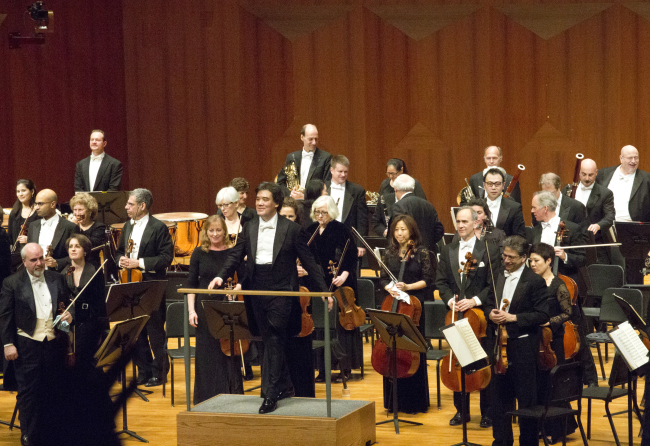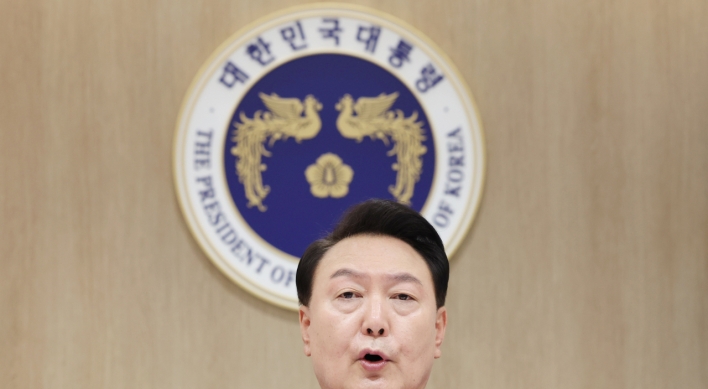New York Philharmonic delivers energetic Seoul concerts
By Korea HeraldPublished : Feb. 9, 2014 - 19:21
For New York Philharmonic music director Alan Gilbert, silence in the audience is not always the same.
“There is a difference between a silence that is focused and a silence that is merely dutiful,” Gilbert said in a press conference hours before a concert Thursday in Seoul.
“With the Korean audience, I have always sensed an energetic concentration.”
“There is a difference between a silence that is focused and a silence that is merely dutiful,” Gilbert said in a press conference hours before a concert Thursday in Seoul.
“With the Korean audience, I have always sensed an energetic concentration.”

And that seemed to be the most accurate description of the mood last week inside the Seoul Arts Center Concert Hall, where the American conductor led his hometown orchestra to gripping performances of Beethoven and Tchaikovsky on Thursday and American composers Rouse, Bernstein and Gershwin on Friday.
As Gilbert said in his January interview with The Korea Herald, the two concerts, with sharply contrasting programs, showed the breadth of his orchestra’s talent.
The Thursday concert opened with a jovial rendition of the overture to Beethoven’s opera, “Fidelio,” an initially ill-received opera that became widely acclaimed in 1814 after Beethoven undertook several revisions.
Young Korean pianist Da Sol went on to deliver a terrific interpretation of Beethoven’s Piano Concerto No. 3 in C Minor, Op. 37. The 24-year-old soloist impressed the audience with flawless technique, delivery and rhythmical flair while the orchestra accompanied each movement with finesse, creating a sonorous dialogue between the piano and the orchestra.
Gilbert had expressed confidence in the pianist as well as his concerto performance earlier that day. “When I first met Da Sol in New York last year, I was immediately struck by his natural and beautiful sound. After our dress rehearsal, I knew it (the concert) would go well. It was as if we had been playing this together for a long time,” said the conductor during the press conference.
As soon as the concerto’s jaunty finale, “Rondo Allegro,” came to a close, the crowd broke into a wholehearted applause, inviting the pianist and conductor to return to the stage five times.
The orchestra concluded the program with Russian composer Tchaikovsky’s masterpiece Symphony No. 5 in E Minor, Op. 64., which began with clarinets playing broodingly in unison, followed by an interchange between the woodwinds and strings. Time and again, the orchestra escalated into the primary melody with full intensity and emotion, nailing the symphony’s famous theme of “fate.”
In stark contrast, the second movement featured an elegant woodwind section accompanied by the sonorities of the strings, forming a graceful conversation briefly interrupted by the vehement and fully orchestrated restatement of the theme, before coming to a close.
After delivering a dreamy waltz in the third movement, the orchestra energetically launched into the last movement, pronounced by the strings and the brass. With rhythmic vivacity, the orchestra delivered varied recapitulations of the theme, building up to the victorious climax.
During the infamous “false” stop several minutes before the finale, not a single soul in the audience moved or breathed. The stirring symphony came to a magnificent close as each section moved in perfect synchrony and sound.
The crowd erupted into a grand applause, with many cheering and giving standing ovations. The applause did not die down for several minutes, which prompted Gilbert to run back onto the stage and lead the orchestra in an encore performance of the overture to Glinka’s opera “Ruslan and Ludmila.”
“I was absolutely mesmerized by the last movement of the Tchaikovsky. I can’t even begin to put into words the intense awe I felt,” said Song Jin-sun who attended the concert on Thursday night. “I hope for another awe-inspiring performance in the near future.”
The Friday program showcased some of the most famous works by American composers, including Christopher Rouse’s “Rapture,” Leonard Bernstein’s “Symphonic Dances” from “West Side Story,” and Gershwin’s “An American in Paris” and “Rhapsody in Blue,” featuring Japanese pianist Makoto Ozone.
“The thing about the New York Philharmonic that I have always been struck by is how versatile and original they are. Every (piece of) music is played with such integrity and appropriate sound,” Gilbert said.
Indeed, the New York Philharmonic has once again proven itself to be one of the world’s most highly acclaimed orchestras with a vivid spectrum of orchestral colors and textures as well as musical finesse.
The American orchestra is set to continue its Asia tour this week, performing in the Japanese cities of Nagoya, Osaka, Tokyo and Yokohama, and in Taipei.
By Sohn Ji-young (jiyoung.sohn@heraldcorp.com)
-
Articles by Korea Herald












![[KH Explains] How should Korea adjust its trade defenses against Chinese EVs?](http://res.heraldm.com/phpwas/restmb_idxmake.php?idx=644&simg=/content/image/2024/04/15/20240415050562_0.jpg&u=20240415144419)







